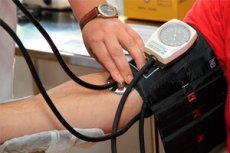Medical expert of the article
New publications
Pre-exercise examination
Last reviewed: 08.07.2025

All iLive content is medically reviewed or fact checked to ensure as much factual accuracy as possible.
We have strict sourcing guidelines and only link to reputable media sites, academic research institutions and, whenever possible, medically peer reviewed studies. Note that the numbers in parentheses ([1], [2], etc.) are clickable links to these studies.
If you feel that any of our content is inaccurate, out-of-date, or otherwise questionable, please select it and press Ctrl + Enter.

Evaluation of children and adults should include history taking and clinical examination (including blood pressure, supine and standing cardiac auscultation). These measures are aimed at identifying the few young patients who appear healthy but are at high risk of life-threatening cardiac disease (eg, hypertrophic cardiomyopathy or other structural heart disease). A more objective determination of whether a person can participate in sports can be made by taking into account existing injuries and impairments, optimizing treatment, and eliminating unnecessary restrictions.
Two risk groups are generally considered. Boys who mature late in life are at higher risk of sports injury when in contact with older, stronger children, and overweight or obese individuals who participate in activities that require rapid movements, as they may be more susceptible to sudden stops and starts due to their extra body weight.
Adolescents and young adults should be questioned about their use of illicit and performance-enhancing drugs. In women, screening should look for late menarche and the presence of the female athlete triad (eating disorders, amenorrhea or other menstrual dysfunction, low bone mineral density), which is becoming more common as more girls and young women engage in excessive exercise and fanatical weight loss.
Older adults beginning exercise should be asked about previous diagnoses or symptoms suggestive of coronary artery disease or arrhythmia, and joint disorders, especially in joints that bear heavy loads (eg, knees, hips, ankles). Also of concern are elevated plasma cholesterol, obesity, hypertension, and a family history of coronary artery disease.
There are almost no absolute contraindications to playing sports. Exceptions in children include myocarditis, which increases the risk of sudden cardiac death; acute enlargement of the spleen, which increases the risk of rupture; fever, which reduces exercise tolerance and increases the risk of thermal imbalance, thereby increasing the risk of cardiac disorders; diarrhea with the risk of dehydration. Exceptions in adults include angina pectoris and recent (within 6 weeks) acute myocardial infarction. Contraindications are usually relative and determine recommendations to observe precautions or participate in some more preferable sports. For example, people with multiple concussions should participate in sports that exclude another concussion; men with one testicle should wear a protective bandage in certain sports; people who do not tolerate heat and dehydration well (for example, patients with diabetes or patients with cystic fibrosis) should drink fluids more often during physical activity; and those who experience cramps should avoid swimming, lifting weights, and sports such as archery and rifle shooting, as these are dangerous to others.


 [
[